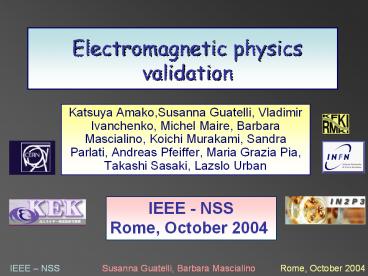Electromagnetic physics validation - PowerPoint PPT Presentation
Title:
Electromagnetic physics validation
Description:
Alpha CSDA range and Stopping Power (no multiple scattering, no ... Protons and alpha particles. Comparison of Geant4 models with respect to ICRU 49 protocol ... – PowerPoint PPT presentation
Number of Views:28
Avg rating:3.0/5.0
Title: Electromagnetic physics validation
1
Electromagnetic physicsvalidation
- Katsuya Amako,Susanna Guatelli, Vladimir
Ivanchenko, Michel Maire, Barbara Mascialino,
Koichi Murakami, Sandra Parlati, Andreas
Pfeiffer, Maria Grazia Pia, Takashi Sasaki,
Lazslo Urban
IEEE - NSS Rome, October 2004
2
Aim of the project
- Validation of Geant4 electromagnetic models
against established references (ICRU - NIST) - Simulation of physics quantities in the same
experimental set-up as reference data - Rigorous quantitative statistical comparison
Quantitative statistical analysis
PHYSICAL TEST
GOODNESS-OF-FIT TESTING
3
Geant4 Electromagnetic Physics models
It handles electrons and positrons, gamma, X-ray
and optical photons, muons, charged hadrons, ions
Standard Package
Geant4 Electromagnetic Package
LowEnergy Package
- multiple scattering
- bremsstrahlung
- ionisation
- annihilation
- photoelectric effect
- Compton scattering
- Rayleigh effect
- gamma conversion
- ee- pair production
- synchrotron radiation
- transition radiation
- Cherenkov
- refraction
- reflection
- absorption
- scintillation
- fluorescence
- Auger
Muon Package
Optical photon Package
- Alternative models for the same physics process
- High energy models
- fundamental for LHC experiments, cosmic ray
experiments etc. - Low energy models
- fundamental for space and medical applications,
neutrino experiments, antimatter spectroscopy
etc. - two flavours of models
- model based on Livermore libraries
- à la Penelope
4
Physics quantities under study
- Photon Attenuation Coefficient
- Photon Cross Sections (attenuation coefficients
with only one process activated) - Electron CSDA range and Stopping Power
- (no multiple scattering, no energy fluctuations)
- Proton CSDA range and Stopping Power
- (no multiple scattering, no energy fluctuations)
- Alpha CSDA range and Stopping Power
- (no multiple scattering, no energy fluctuations)
Elements Be, Al, Si, Fe, Ge, Ag, Cs, Au, Pb, U
water
Energy range 1 keV 10 GeV
Testing activity has been automatised (INFN Gran
Sasso Laboratory and KEK)
5
Statistical analysis
- The statistical analysis has been performed by
means of a Goodness-of-Fit Statistical Toolkit - The two hypothesis under study are the
following - H0 Geant4 simulations NIST data
- H1 Geant4 simulations ? NIST data
Distance between Geant4 simulations and NIST
reference data
GoF Toolkit
GoF test (?2 test)
Test result (p-value)
6
Photon attenuation coefficient
Experimental set-up
Geant4 LowE Penelope Geant4 Standard Geant4 LowE
EPDL NIST - XCOM
- The three Geant4 models reproduce total
attenuation coefficients with high accuracy - The two Geant4 LowE models exhibit the best
agreement
7
Photoelectric cross section
- The three Geant4 models reproduce photoelectric
cross sections with high accuracy - The two Geant4 LowE models exhibit the best
agreement
p-value stability study
Geant4 LowE Penelope Geant4 Standard Geant4 LowE
EPDL NIST - XCOM
Geant4 LowE Penelope Geant4 Standard Geant4 LowE
EPDL
8
Compton scattering cross section
- The three Geant4 models reproduce Compton
scattering cross sections with high accuracy - The Geant4 LowE EPDL model exhibits the best
agreement
Geant4 LowE Penelope Geant4 Standard Geant4 LowE
EPDL NIST - XCOM
9
Pair production cross section
- The three Geant4 models reproduce pair
production cross sections with high accuracy - The Geant4 LowE EPDL model exhibits the best
agreement
p-value stability study
Geant4 LowE Penelope Geant4 Standard Geant4 LowE
EPDL
Geant4 LowE Penelope Geant4 Standard Geant4 LowE
EPDL NIST - XCOM
Z
10
Rayleigh scattering cross section
The Geant4 models seem to be in disagreement with
the reference data
p-value stability study
Geant4 Penelope Geant4 LowE EPDL NIST - XCOM
Z
11
Rayleigh scattering cross section
- The NIST database and the EPDL97 evaluated data
library give Rayleigh cross section data in
disagreement for E lt 1 MeV - EPDL97 is the most up-to- date, complete and
consistent data library available at the moment
(Zaidi, 2000).
NIST
EPDL 97
Zaidi H., 2000, Comparative evaluation of
photon cross section libraries for materials of
interest in PET Monte Carlo simulation IEEE
Transaction on Nuclear Science 47 2722-35
12
Electron Stopping Power
Experimental set-up
centre
p-value stability study
Geant4 LowE Penelope Geant4 Standard Geant4 LowE
EEDL NIST - XCOM
p-value
Geant4 LowE Penelope Geant4 Standard Geant4 LowE
EEDL
The three Geant4 models are equivalent
H0 REJECTION AREA
Z
13
Electron CSDA Range
CSDA range particle range without energy loss
fluctuations and multiple scattering
p-value stability study
Geant4 LowE Penelope Geant4 Standard Geant4 LowE
EEDL NIST - XCOM
Geant4 LowE Penelope Geant4 Standard Geant4 LowE
EEDL
The three Geant4 models are equivalent
Z
14
Protons and alpha particles
- Comparison of Geant4 models with respect to ICRU
49 protocol - Geant4 LowE Package has ICRU 49
parameterisations as one of its
models verification, not validation - The Ziegler parameterisations are as
authoritative as the ICRU 49 reference - comparison rather than validation
15
Stopping Power and CSDA Range
Proton stopping power
Proton CSDA range
Geant4 LowE ICRU Geant4 Standard Geant4 LowE
Ziegler 85 Geant4 LOWe Ziegler 2000 NIST PSTAR -
ICRU 49
pgt0.05
Geant4 LowE ICRU Geant4 Standard Geant4 LowE
Ziegler 85 Geant4 LOWe Ziegler 2000 NIST PSTAR -
ICRU 49
Geant4 LowE ICRU Geant4 Standard Geant4 LowE
Ziegler 85 Geant4 LOWe Ziegler 2000 NIST PSTAR -
ICRU 49
pgt0.05
Similar results for alpha particles
16
Conclusions
- Systematic validation of Geant4 electromagnetic
models against ICRU protocols and NIST reference
data - Validation based on a rigorous, quantitative
statistical analysis of test results - All Geant4 electromagnetic models are in
agreement with the reference data - The Geant4 Low Energy Package is the most
accurate with respect to the ICRU protocol - More results http//www.ge.infn.it/geant4/analysi
s/book - Future extend the validation test to other
physics quantities































